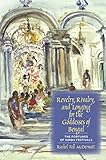Revelry, Rivalry, and Longing for the Goddesses of Bengal : The Fortunes of Hindu Festivals / Rachel Fell McDermott.
Material type: TextPublisher: New York, NY : Columbia University Press, [2011]Copyright date: ©2011Description: 1 online resource (392 p.) : 37 illusContent type:
TextPublisher: New York, NY : Columbia University Press, [2011]Copyright date: ©2011Description: 1 online resource (392 p.) : 37 illusContent type: - 9780231129190
- 9780231527873
- 294.536095414 23
- BL1239.82.D87 M33 2011
- BL1239.82.D87 M33 2015
- online - DeGruyter
- Issued also in print.
| Item type | Current library | Call number | URL | Status | Notes | Barcode | |
|---|---|---|---|---|---|---|---|
 eBook
eBook
|
Biblioteca "Angelicum" Pont. Univ. S.Tommaso d'Aquino Nuvola online | online - DeGruyter (Browse shelf(Opens below)) | Online access | Not for loan (Accesso limitato) | Accesso per gli utenti autorizzati / Access for authorized users | (dgr)9780231527873 |
Frontmatter -- Contents -- Illustrations -- Preface -- Acknowledgments -- Notes on Transliteration -- Introduction -- 1. Pūjā Origins and Elite Politics -- 2. The Goddess in Colonial and Postcolonial History -- 3. Durgā the Daughter: Folk and Familial Traditions -- 4. The Artistry of Durgā and Jagaddhātrī -- 5. Durgā on the Titanic: Politics and Religion in the Pūjā -- 6. The "Orientalist" Kālī: A Tantric Icon Comes Alive -- 7. Approaches to Kālī Pūjā in Bengal -- 8. Controversies and the Goddess -- 9. Devī in the Diaspora -- Conclusion -- Appendix -- Notes -- Bibliography -- Index
restricted access online access with authorization star
http://purl.org/coar/access_right/c_16ec
Annually during the months of autumn, Bengal hosts three interlinked festivals to honor its most important goddesses: Durga, Kali, and Jagaddhatri. While each of these deities possesses a distinct iconography, myth, and character, they are all martial. Durga, Kali, and Jagaddhatri often demand blood sacrifice as part of their worship and offer material and spiritual benefits to their votaries. Richly represented in straw, clay, paint, and decoration, they are similarly displayed in elaborately festooned temples, thronged by thousands of admirers. The first book to recount the history of these festivals and their revelry, rivalry, and nostalgic power, this volume marks an unprecedented achievement in the mapping of a major public event. Rachel Fell McDermott describes the festivals' origins and growth under British rule. She identifies their iconographic conventions and carnivalesque qualities and their relationship to the fierce, Tantric sides of ritual practice. McDermott confronts controversies over the tradition of blood sacrifice and the status-seekers who compete for symbolic capital. Expanding her narrative, she takes readers beyond Bengal's borders to trace the transformation of the goddesses and their festivals across the world. McDermott's work underscores the role of holidays in cultural memory, specifically the Bengali evocation of an ideal, culturally rich past. Under the thrall of the goddess, the social, political, economic, and religious identity of Bengalis takes shape.
Issued also in print.
Mode of access: Internet via World Wide Web.
In English.
Description based on online resource; title from PDF title page (publisher's Web site, viewed 02. Mrz 2022)


